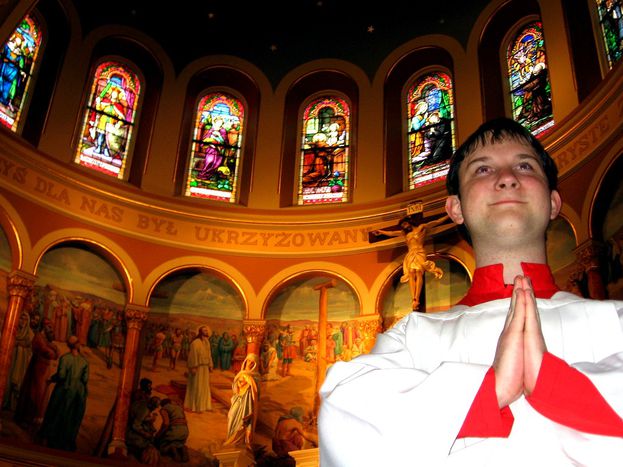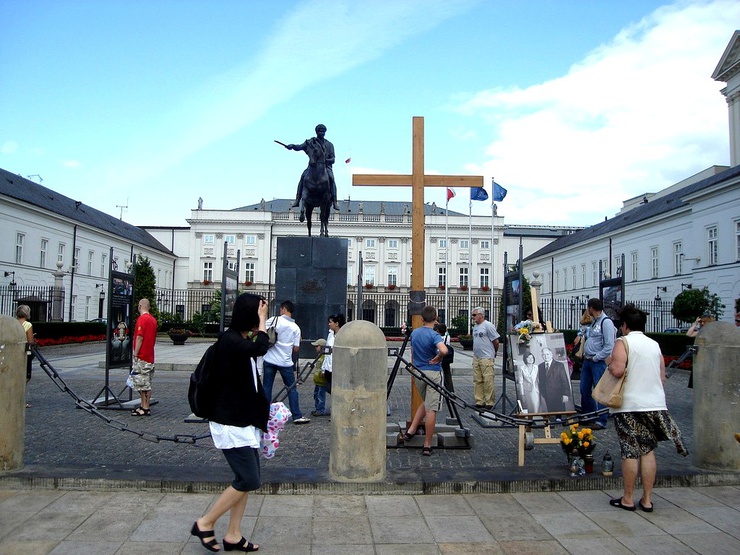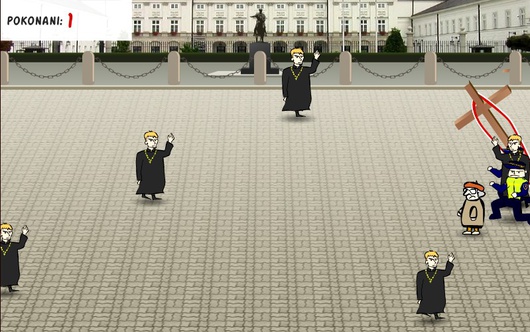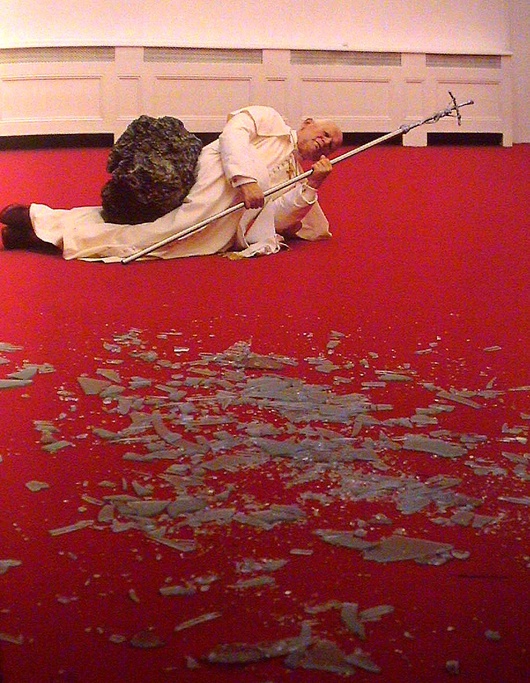
World's tallest jesus and crossing out secularism in Poland
Published on
Translation by:
 Ems_8674
Ems_8674
Every country has its own vision of secularism.In late November, a 51-metre Jesus Christ statue was erected in western Poland, 14 metres taller than its colleague in Rio de Janeiro. Though privately funded, the Polish state is still looking for that perfect balance between sacrum and profanum in the public domain - takes its various crossings with the cross
Is there anyone out there who hasn’t seen the photos of hundreds of Poles gathered together beneath an 8-meter high cross in front of the presidential palace in Warsaw, the day after the tragic death of Lech Kaczyński? Born of good intentions, the symbol of reverence, set up by scouts, has instead become a burden for the new team headed by Bronisław Komorowski; the president dared to consider moving the giant cross to Saint Anne’s church. The protests that followed ended in clashes between defenders and supporters of the cross. Besides the issue of the cross, the conflict revealed the separation of the country, between the young, progressive generation and the old guard who aren’t yet ready to give up their conservative ways, headed by the law and justice party (headed by opposition leader Jaroslaw Kaczyński). Along the banks of the Vistula, secularism is tantamount to Hell.

Cross stations in Poland
Amazingly, the Polish media has made little connection between the recent crusade in Warsaw and that in Auschwitz in 1999, when the crosses were finally removed from the camp. Yet there are quite a few resemblances between the two events: the same taking of sides, the same slow pace, the same media disaster.
 In 1979, during his first pilgrimage to his home country, Pope John-Paul II celebrated a mass in the Auschwitz camp and an 8.6 metre-high cross was erected. Nearly a decade on, following protestations from some Polish and international Jewish organisations, the cross was moved to wildlands adjacent to the Auschwitz camp, where 152 Polish political prisoners had been shot by the nazis. Fearing the cross would simply just disappear, Polish catholic conservatives headed by the radical Silesian dissident Kazimierz Switon. He went on hunger strike, demanding the cross stay. The conflict degenerated when neither the state nor the church reacted. Defenders of the cross installed dozens, then hundreds of smaller crosses around the pope’s cross. It wasn’t until a year and a half later that the conflict ended, with the decision to keep the pope’s cross where it was. Meanwhile, just as in 2010, the media storm had ruined Poland’s image on the international scene without advancing the debate on the place of religious symbols in public spaces.
In 1979, during his first pilgrimage to his home country, Pope John-Paul II celebrated a mass in the Auschwitz camp and an 8.6 metre-high cross was erected. Nearly a decade on, following protestations from some Polish and international Jewish organisations, the cross was moved to wildlands adjacent to the Auschwitz camp, where 152 Polish political prisoners had been shot by the nazis. Fearing the cross would simply just disappear, Polish catholic conservatives headed by the radical Silesian dissident Kazimierz Switon. He went on hunger strike, demanding the cross stay. The conflict degenerated when neither the state nor the church reacted. Defenders of the cross installed dozens, then hundreds of smaller crosses around the pope’s cross. It wasn’t until a year and a half later that the conflict ended, with the decision to keep the pope’s cross where it was. Meanwhile, just as in 2010, the media storm had ruined Poland’s image on the international scene without advancing the debate on the place of religious symbols in public spaces.
Cross and crotch
Poland’s recent history is full of examples that show just how much trouble the Poles have in distinguishing the sacrum from the profanum. Who could forget the spectacular destruction of the Nona Ora (‘the ninth hour’) sculpture by Maurizio Cattelan? The piece, exhibited at the famous Zacheta gallery in Warsaw in 2001 to mark its centenary, depicted Pope John Paul II, a cross in his hand, being crushed by a meteorite. Right-wing MP Witold Tomczak, one of the leaders of the extreme right league of Polish families (Liga Polskich Rodzin, LPR) party, decided to free the pope from the weight of the rock and demolished the work of art. ‘I destroyed it because that was what my voters expected me to do,’ he said to justify himself in the press. As a result, the director of the gallery resigned and the artist removed his work. Curiously, however, it went on to sell in New York in 2008 for a mere $886, 000.
 Less well known than Maurizio Cattelan is the contemporary artist Dorota Nieznalska, although she too has experienced the wrath of the Polish radical right wing. In 2002, she was exhibiting an installation displaying a Greco-Roman cross in the stead of male genitals and a video of a man doing sports at the Wyspa gallery in Gdansk. Entitled The Passion, the work underlined the double sense of the term which, beyond religious acceptance, means simply an avid interest in an activity - in this case, sport. Enraged, the catholic conservatives put it to the courts. Six months in prison became community service for insulting religious symbols (though Nieznalska was cleared of the charge on 11 March 2010 - ed). The courts’ decision is all the more shocking given that even the church itself accepted the freedom of expression of the artist. ‘She was the victim of an unfounded debate which does nothing but boost the political capital of the conservative opposition,’ declared Krzysztof Niedalkowski, a priest and supporter of the Polish art scene. ‘Several of them never even saw the piece, others forgot that it had an artistic purpose.’
Less well known than Maurizio Cattelan is the contemporary artist Dorota Nieznalska, although she too has experienced the wrath of the Polish radical right wing. In 2002, she was exhibiting an installation displaying a Greco-Roman cross in the stead of male genitals and a video of a man doing sports at the Wyspa gallery in Gdansk. Entitled The Passion, the work underlined the double sense of the term which, beyond religious acceptance, means simply an avid interest in an activity - in this case, sport. Enraged, the catholic conservatives put it to the courts. Six months in prison became community service for insulting religious symbols (though Nieznalska was cleared of the charge on 11 March 2010 - ed). The courts’ decision is all the more shocking given that even the church itself accepted the freedom of expression of the artist. ‘She was the victim of an unfounded debate which does nothing but boost the political capital of the conservative opposition,’ declared Krzysztof Niedalkowski, a priest and supporter of the Polish art scene. ‘Several of them never even saw the piece, others forgot that it had an artistic purpose.’
Secularism or secularisation
After six months of conflict, the cross in front of the presidential palace finally found a calm resting place at Saint Anne’s church on 16 September, in exchange for the government’s promise to build a monument commemorating the death of former president and his wife Lech and Maria Kaczyński. However, the issue of the place and meaning of religious symbols in public spaces in Poland has not gone away. One recent resolution of the Polish parliament regarding the freedom of confession adds yet more to the ambiguity surrounding the cross, affirming that the cross ‘is not a strictly religious symbol; it implies the notion of sacrifice for others. The cross also reflects the libertarian tradition in Poland, which was once a model country when it comes to tolerance for other nations and religions.’
The cross reflects the libertarian tradition in Poland, once a model country when it comes to tolerance
So is secularism in Poland impossible? According to Polish philosopher Halina Bortnowska, a ‘modern state must be a secular state, as only secularism created the necessary conditions for the coexistence of the plurality of points of view,’ she declared on radio Tok FM. ‘But secularism cannot be confused with secularisation, which is understood as an attempt to eradicate the presence of religion, as the communist powers managed to do.’ The debate is only just getting started.
Images: main (cc) justone73; cross (cc) galio; 'Nona Ora' (cc)I M A U-M-N-B-N!/ all courtesy of Flickr
Translated from La Pologne fait-elle une croix sur la laïcité ?


